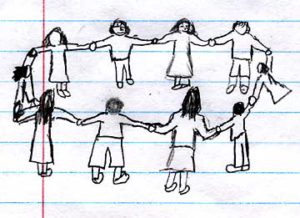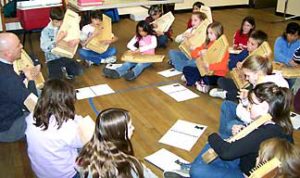School principals and others may use this page justifying arts in the curriculum.
Why Do We This?
Folk dancing has several benefits, both physical and mental. It provides a fun way to exercise and improve cardiovascular health, flexibility, and coordination. Additionally, folk dancing often involves social interaction, which can help reduce stress and improve mood. It also allows for cultural expression and preservation, as many folk dances are tied to specific traditions and histories. Overall, folk dancing can contribute to a sense of community, physical well-being, and cultural enrichment.
The Neuroscience of Dance
Research by Hanna Poikonen in Psychology Today
Dancing engages and changes the brain in unique ways.
“In dance, the basic elements of humanity combine in a natural way. It combines creative act, fine-tuned movement and collaboration, much like playing music. The movement involves the whole body, like in sports. . . Studies on producing music and movement show how during cooperation, the brains of two people become attuned to the same frequency. This is apparent in how the low-frequency brain waves of the participants become synchronized.
Brain synchronization enables seamless cooperation, and is necessary for creating both harmonic music and movement. The ability to become attuned to another person’s brain frequency is essential for the function of any empathetic community.”
See Evo’s dance residency page.

Benefits of Group Singing (article by Brian Eno in openculture.com)
English musician, composer, record producer, singer, writer, and visual artist Brian Eno wrote:
“I believe in singing,” says Eno. “I believe in singing together.” He expounds upon this belief in an NPR segment called “Singing: The Key to a Long Life.” He also credits the practice with the ability to ensure “a good figure, a stable temperament, increased intelligence, new friends, super self-confidence, heightened sexual attractiveness and a better sense of humor.” It offers the chance to “use your lungs in a way that you probably don’t for the rest of your day, breathing deeply and openly,” to experience “a sense of levity and contentedness,” and to “learn how to subsume yourself into a group consciousness.”
Years of group singing have convinced Eno of singing’s importance to our very civilization, to the point that, as he says, “if I were asked to redesign the British educational system, I would start by insisting that group singing become a central part of the daily routine. I believe it builds character and, more than anything else, encourages a taste for co-operation with others.” And it would certainly encourage whichever student turns out to be the next, well, Brian Eno. –openculture.com

Benefits of Arts Education (from California Alliance for Arts Education)
• Higher attendance rates and lower drop out rates
• Increases parent and community involvement
• Decreases disciplinary problems and encourages positive student attitudes about their classroom
• The arts have a central and essential role in achieving the finest aspects of the common core
• Theater, dance, music and the visual arts are a valued part of a broad course of study, as set out in the state education code
• Boosts test scores and achievement in literacy, math skills and ELA especially for English Language Learners and low-income students
• Increases graduation rates, fosters 21st Century work skills like creativity, critical thinking and collaboration
More good links when justifying arts in the Curriculum
Dance and Math
Music–All Children
Brain Help–Learn Music!
Science Says Best Workout–Dance!
Confirmed: Dancing Makes You Happy
How Music Strengthens the Brain
Child’s Brain and Music Education
Music linked to achievement
Art Benefits in Education
Music and High School
Science & Music Lessons
Piano Brain
Choir Brain
Life Lessons from Music
Making Music
